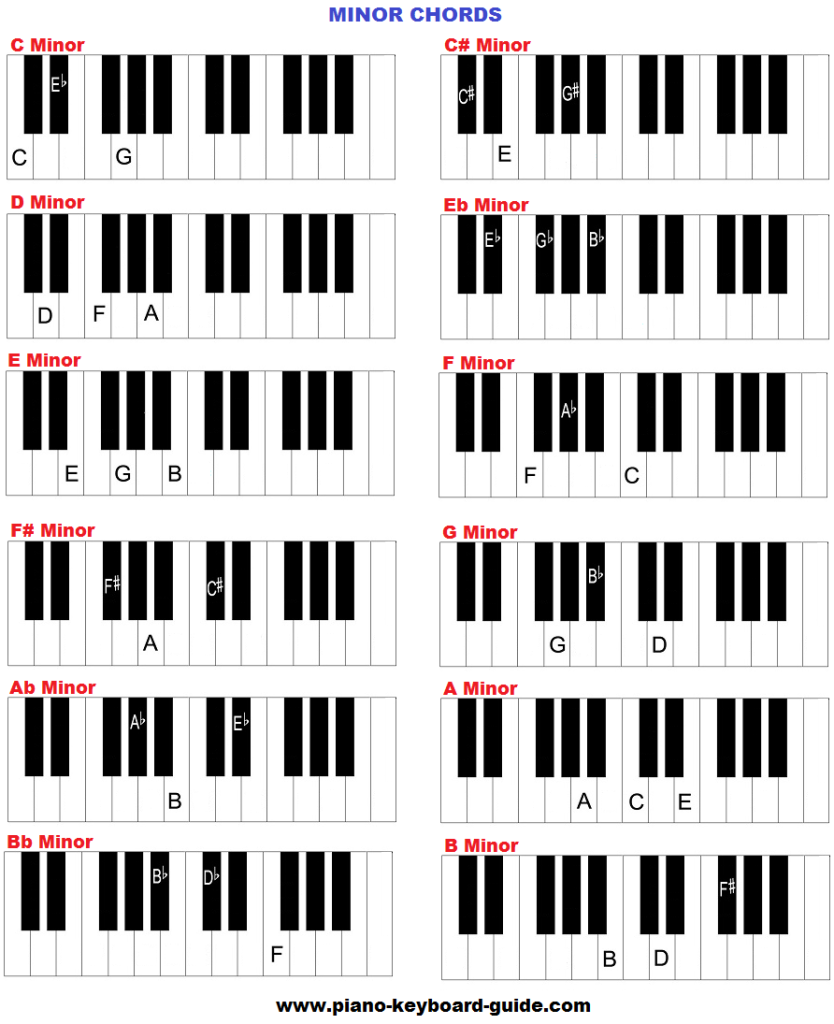Welcome to our piano lesson on minor chords. You will learn how to play this chord in every key.
The first chord we will start with is A minor. This chord consists of three notes, A, C and E. How did we come up with this chord? A simple way to do it is to play a key, skip two keys, play a key, skip three keys and play a key. To form A minor, play the key, A, skip two keys (Bb and B), play C, skip three keys (C#, D and Eb) and play E. A-C-E is an A minor chord, also written, Am or Amin. Play this chord with the left hand as well, using fingers 1, 3 and 5. Fingers 1, 3 and 5 is used for the right hand as well. (Learn about finger numbers.)
Watch this lesson:
Let’s start on the note, E. To form an Em chord, like we did with the Am chord, we play a key, skip two keys, play a key, skip three keys and play a key. So in that case, we play E, skip two keys (F and F#), play G, skip three keys (Ab, A and Bb) and play B. E-G-B played together is an Emin chord.
You can use this method of skipping keys anywhere on your keyboard. For instance, if you start on D, you will end up with the notes, D, F and A.
Let’s say you start on B flat. You end up with the notes, Bb, Db and F. The Bbmin chord is played the same way as an A#min chord. The two chords simply have different names. It’s a Bbmin chord because its notes are a half step lower than Bmin, and it’s an A#min chord because its notes are a half step higher than Amin. You can play this chord with fingers 1, 2 and 5, while Am can be played with fingers 1, 3 and 5. It feels comfortable to play the chord with these fingers.
Try this on every piano key. If you play a key, skip two keys, play a key skip three keys and play a key, you end up with the following minor chords.
Minor Chords List
C minor: C–Eb–G
C sharp minor: C#–E–G# (D flat minor: Db–Fb–Ab)
D minor: D–F–A
D sharp minor: D#–F#–A# (E flat minor: Eb–Gb–Bb)
E minor: E–G–B
F minor: F–Ab–C
F sharp minor: F#–A–C# (G flat minor: Gb-Bb-Db)
G minor: G–Bb–D
A flat minor: Ab–Cb–Eb (G sharp minor: G#–B–D#)
A minor: A–C–E
B flat minor: Bb–Db–F (A sharp minor: A#–C#–E#)
B minor: B–D–F#

Practice these chords with each hand separately, then play both hands together. Move up and down your keyboard. The more you practice, the better you will get. You can practice the chords slowly then increase your speed as you get better. Have fun with the chords. Very soon you will master every single minor chord.
I want you to notice that some of the chords have different names but the same keys are played on piano. They are enharmonic equivalents of each other. They are written differently on paper but on your instrument, the same keys are played. While there are 17 chords in the list above, you only have to learn to play 12, really. This is because some of the chords, as I said, have different names but are played the same.
Most of these chords can be played with fingers 1, 2 and 5 or fingers 1, 3 and 5. For instance, play the C#m chord with fingers 1, 2 and 5, and the Dm chord with fingers 1, 3 and 5. Use this as a guide; there is no absolute rule as to what fingers you should play the chords with. It has a lot to do with what feels comfortable.
Learn more about forming minor chords.
To learn how to form other types of chords, check out the piano chords main page.
To take your playing to the next level, get my piano chords book on Amazon or take my piano chords course on Udemy. All the best.